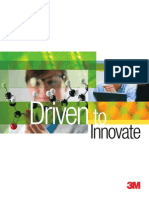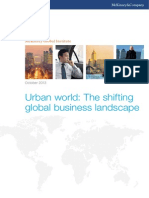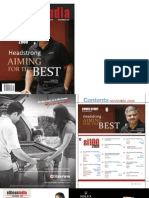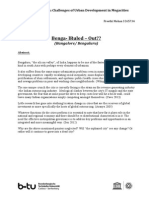Covid and Indian Reality Sector
Covid and Indian Reality Sector
Uploaded by
premohCopyright:
Available Formats
Covid and Indian Reality Sector
Covid and Indian Reality Sector
Uploaded by
premohCopyright
Available Formats
Share this document
Did you find this document useful?
Is this content inappropriate?
Copyright:
Available Formats
Covid and Indian Reality Sector
Covid and Indian Reality Sector
Uploaded by
premohCopyright:
Available Formats
Mr.
Ramesh Kumar Santhanam
Founder CPMS, Retd. Jt.GM. HDFC
8 July y
Will Real Estate market take U-Turn,
post lock-down
Technology to Enhance Commercial Real Estate Resilience
and Flexibility
I start my thoughts with my own institution HDFC, where I spent almost 3 decades, learning
everyday something new and creative.
“Even at these difficult times.”
OMG !!!! should we even say so like this, as we used to say so at any earlier times of crisis.
This time it is so so different from any other crisis.
No organisation – large or small has been prepared to face this disruption. Decision-making,
keeping the best interests of employees and the organisation is now hard when there are so
many unknowns and no past experience to fall back upon. However, even in the toughest of
situations, it is necessary to get the priorities right – employee safety, business continuity and
adhering to the purpose the organisation that exist, which is to serve its customers.
The management echoes that not a single job at HDFC is trivial. And it is very important to
hold up everything in these trying times. For the first time ever all of employees of the
organisation are working remotely, but what matters is that all are still working seamlessly
together, relying on collective wisdom and upholding the values that HDFC stands for & has
built so strongly over four decades.
Technology has prevented the business from coming to a grinding halt. The leads, approvals
and some disbursements as also deposits and fund raising is being done online, despite the
difficult markets. The IT and IT support teams have been the backbone through this present
crisis. Yet, while every employee works from home today, we all realise how much more is
needed to leverage technology to make business more efficient.
WILL REAL ESTATE MARKET POST LOCK-DOWN 1
Technology will continue to be the prime factor to drive our businesses in future and one has
to dedicate to business with even stronger commitment to go the extraordinary lengths
gaining customers and stakeholders loyalty.
The question that emerges clearly is do we need to do business differently? What processes
and systems should we change? Where will our new opportunities lie and where could we be
most vulnerable? How do we rethink budgets and targets? What will be the new normal
business look like?
I will like to quote two of my favourite and time specific advises from -
STOP SKETCHING, START BUILDING - says Dennis Crowley, of Four Square.
MAKE SOMETHING PEOPLE WANT – Paul Graham, Y Combinator.
The Coronavirus outbreak, which originated in China, has infected lakhs of people
worldwide. Simultaneously, it has disrupted industries, trade, and business cycles, thus
halting global economic activity significantly. Indian real estate sector, which was already
struggling to re-emerge from the past turbulence of structural changes, policy reforms, and
the liquidity crisis, is now set to witness another major fallout. Unfortunately, 2020 wasn't
very different. Country-wide lockdown until end-April has halted all activities.
The usually robust commercial real estate is also not immune to the Covid-19 fallout. Several
MNCs and businesses are testing new waters of the work from-home option. If proved
successful, it could impact leasing activities in the future. And will be the new game changer
and new work culture.
Real Estate market must recognise this and start building up their plans and strategies. Here, I
do not intend to bring in the various regulations and approvals from authorities in our thought
process. Because that is a different ball game and players in the market know that well and
will learn to handle that uniquely and differently with change in patterns that we intend to
discuss here.
Colliers, an International Leader in Real estate services and Investment management,
recommends occupiers to focus on optimising office space by studying user patterns, and by
incorporating a flex and core model that suits their business needs.
WILL REAL ESTATE MARKET POST LOCK-DOWN 2
Sankey Prasad, Managing Director & Chairman at Colliers International India says:
- Flexible workspace operators should maintain a tight ship on operations and
finances, as investors become more stringent with due diligence
- Flexible workspaces have grown rapidly in India since 2017, with the sector
garnering 18% share in total leasing in 2019 (leasing ~11.2 million sq ft in 2019). In 2020,
the flexible workspace market should start seeing consolidation, as larger flexible workspace
operators with financial discipline acquire smaller companies.
He also points to consolidation beginning in the market, with Indian hospitality chain OYO
acquiring Gurgaon-based flexible workspace company, Innov8 in July 2019. The market
should enter a phase of maturity with smaller players with lesser financial muscle even
exiting the market.
Now to take stock of the US based firms and its impact-
With US becoming the new epicentre of COVID-19 and thus witnessing one of its worst
economic blows, the economic repercussions may soon hit India, as well. As things stand
now, US private equity funds which have been substantially active in Indian real estate since
2015 may reconsider their India investment plans, leading to a decline in total inflows in
2020.
However, some of the cash-rich funds could also leverage the COVID-19 fallout to optimal
advantage. As and when they enter Indian shores (hopefully towards second half of 2020),
they will scout for good bargains and value-pick options on their own terms. Indian
developers may see reduced valuations.
In retrospect, US-based private equity players pumped nearly USD 5.7 bn into Indian real
estate between 2015 to 2019, accounting for a nearly 29% overall share. On a y-o-y basis, PE
inflows by US firms increased from a mere USD 526 million in 2016 to over USD 1.8 bn in
2019. Concurrently, their share has also increased – from 21% to 36% during the same
period.
Other prominent PE players investing in Indian real estate are based out of Singapore,
Canada, and UAE, among others.
Shobhit Agarwal, MD & CEO, ANAROCK Capital says, “India has been a major draw for
US-based private equity players over the last few years. In 2019 alone, US-based firms
comprised 36% share and pumped in ~ USD 1.8 bn out of the total USD 5 bn PE inflows in
Indian realty. However, considering the rising pandemic fallout in the US, there is high
possibility that inflows will drop significantly in 2020, thus impacting overall inflows into the
country.”
WILL REAL ESTATE MARKET POST LOCK-DOWN 3
Segment-wise Inflows
Notably, a major chunk of the US-based private equity inflows in India since 2015 focused
on the lucrative commercial real estate segment, with Blackstone as the top investor.
• Of the total USD 5.7 bn PE funds pumped in between 2015 to 2019, close to USD 3.5
bn (61%) targeted commercial real estate
• The retail real estate segment came next, attracting nearly USD 1 bn
• Residential real estate drew close to USD 500 mn, and over USD 400 mn targeted
mixed-use developments
• More than USD 300 mn were pumped into the logistics and warehousing sectors.
“Current estimates of the COVID-19 impact on Indian commercial real estate indicate net
office space absorption across the top 7 cities will plummet by 13-30% in 2020 against
preceding year, “ says Shobhit Agarwal. “This is because most multi-nationals and domestic
businesses will re-strategize their expansion plans and optimize operational costs in the wake
of the COVID-19 pandemic. All these factors will inevitably impact the Indian investment
plans of US private equity majors as well.
Now if we just take a back step and look back into the work from home or telecommuting
concept -
Pros : workers tend to prefer working from home, it reduces emissions and office costs, and
it helps people (especially women) balance work and family roles. It may even make us more
productive.
Cons : managing a telecommuting staff can be difficult, professional isolation can have
negative effects on well-being and career development, and the effects on productivity over
the long run and in a scaled-up system are uncertain.
“We are home working alongside our kids, in unsuitable spaces, with no choice and no in-
office days,” says Bloom, a senior fellow at the Stanford Institute for Economic Policy
Research (SIEPR). “This will create a productivity disaster for firms.”
For those even a bit familiar with some of Bloom’s more popular scholarship, the
economist’s dire prediction might come as a surprise. In 2015, the Quarterly Journal of
Economics published a paper he co-authored extolling the benefits of working from home.
The study drew attention and interest from journalists, business leaders and employees
looking to avoid long commutes, skirt office politics and develop a better work-life balance.
That research was based on a randomized control trial on 1,000 employees of Ctrip, a
Chinese travel company. The experiment revealed that working from home during a nine-
WILL REAL ESTATE MARKET POST LOCK-DOWN 4
month period led to a 13 percent increase in performance — almost an extra day of output per
week — plus a 50 percent drop in employee-quit rates. The experiment was so successful that
Ctrip rolled out working from home to the whole firm.
But what’s happening today with the coronavirus crisis is completely different thanks to four
factors: children, space, privacy and choice.
“Many people I have been interviewing are now working in their bedrooms or shared
common rooms, with noise from their partners, family or roommates,” Bloom says.
The Ctrip experiment also explicitly asked employees to work from home four days a week
and come into the office every fifth day. In-person collaboration is necessary for creativity
and innovation, Bloom says. His research has shown that face-to-face meetings are essential
for developing new ideas and keeping staff motivated and focused.
“I fear this collapse in office face time will lead to a slump in innovation,” he says. “The new
ideas we are losing today could show up as fewer new products in 2021 and beyond,
lowering long-run growth.
After nine months of allowing those employees to do their jobs at home, Ctrip asked the
original volunteers whether they wanted to keep working remotely or return to the office.
Half of them requested to return to the office, despite their average commute being 40
minutes each way.
Why was that?
“The answer is social company,” Bloom says. “They reported feeling isolated, lonely and
depressed at home. So, I fear an extended period of working from home will not only kill
office productivity but is building a mental health crisis.”
Despite the drawbacks, Bloom suggests a few things that can help stem the productivity
decline he fears: Regular check-ins between managers and their teams; maintaining schedules
that strive to separate work life from family life; and collaborating with colleagues on video
calls rather than phone calls.
And although he’s concerned productivity will take a nosedive, Bloom says there are a few
things to be optimistic about following the initial crush of the pandemic.
WILL REAL ESTATE MARKET POST LOCK-DOWN 5
If businesses can successfully adopt information technology and have their employees work
remotely in conditions similar to those established by Ctrip, commuting woes can certainly
diminish.
Automation is happening. As business leaders today, we are at a unique threshold with the
ability and — indeed — the responsibility to shape the coming advancement and work now
to ensure these changes come into reality to not only add significant economic benefit, but
fundamentally underpin quality of life for billions of workers across the globe.
If you look at the technology trends highlighted in this year’s report, automation comes into
play significantly in the emergence of chatbot programmes, and the immense capabilities of
IoT in streamlining integrated facilities services — aggregating inventory, facility and
equipment data into a single user-friendly interface.
On the other side of this year’s trends, we see human capital is more important than ever. As
automation takes up the “boring” aspects of work, employee innovation, emotional
intelligence and knowhow — those uniquely human traits — become more important than
ever before.
In other words, it’s not a question of boon or bane, it’s a matter of responsibility to shape the
future we want to see, one that will be best for employees, facilities, customers and the
industry as a whole. So to look at Post-lockdown recommendations for occupiers of flexible
workspaces
If we are to have a future, that future must be green. That’s why green buildings are a core
trend we are highlighting this year, and one that reflects broader shifts in the workplace at
large. Soon, we will see living buildings become an affordable reality — facilities that are
100% supported by their own solar panels and windmills. This will be followed by waste-free
buildings, in which FM teams recycle and reuse the majority of paper, food and trash entirely
onsite.
Finally, we will see buildings that are not only sustainable for the environments, but for their
occupants. Structures that are low on volatile organic compound (VOC) paints, furnishings
and carpets made from natural, non-toxic materials. Designs that seek to maximise the natural
light employees and residents experience each day.
As sustainability becomes an increasing priority for facility occupants and has a major role to
play in improving their quality of life, FM has a true leadership role to play in realizing a
green future.
WILL REAL ESTATE MARKET POST LOCK-DOWN 6
While it is too early to forecast the lasting effects of COVID-19 on flexible workspace, this
pandemic is certain to impact both occupiers’ and operators’ future response plans and
corporate real estate approach. Here are some of the key outcomes we will be tracking:
The massive work-from-home shift, mandated or encouraged by governments globally,
presents the first real opportunity to measure productivity from remote working on a
meaningful scale.
• How will this impact occupier’s willingness to implement remote working of staff
connected by cloud technology in the future and what role will the flexible workspace
sector play here, given not everyone has the ideal environment at home?
• Will a reduction in in-person building tours become persistent and drive adoption of
new technologies to facilitate remote buildings tours?
• Is this a catalyst for the digitization in real estate, with a more widespread adoption of
proptech and A.I. (e.g. robots cleaning, AR/VR touring)?
• Prolonged economic stagnation may present the first real financial stress test for many
new operator entrants into the sector. How will this impact the dynamics of the sector
six months from now?
• Will flexible workspace, split operations or city campus models emerge as key
components of the corporate real estate strategies and business continuity plans for
occupiers during disaster response scenarios?
• What types of new welfare, safety and security protocol will become commonplace for
operators post-COVID-19?
WILL REAL ESTATE MARKET POST LOCK-DOWN 7
Reference
https://techcrunch.com/2011/03/05/founder-stories-foursquare-crowley-stop-sketching-start-
building/
https://www.commercialdesignindia.com/insights/5977-covid-19-will-it-reset-the-indian-real-
estate-sector
https://nbloom.people.stanford.edu/sites/g/files/sbiybj4746/f/wfh.pdf
https://siepr.stanford.edu/news/productivity-pitfalls-working-home-age-covid-19
http://cbre.vo.llnwd.net/grgservices/secure/Viewpoint_Leveraging%20Technology%20to
%20Enhance%20Business%20and%20Real%20Estate%20Resilience%20FINAL.pdf?
e=1586649243&h=2667553b4eed1d8f54aa4044ae95af45
https://www.cbre.com/covid-19
WILL REAL ESTATE MARKET POST LOCK-DOWN 8
You might also like
- A Stranger From LagosDocument26 pagesA Stranger From Lagosapi-27513491760% (5)
- Purchasing Principles & TechniquesDocument100 pagesPurchasing Principles & TechniquesMwanza Malii100% (2)
- Attitude and Performance AppraisalsDocument1 pageAttitude and Performance Appraisalspt.rakeshNo ratings yet
- Real Estate Marketing' (NCR) : Amity School of Business Internship Report ONDocument41 pagesReal Estate Marketing' (NCR) : Amity School of Business Internship Report ONVidushi Gautam100% (1)
- Recession - A Way AheadDocument7 pagesRecession - A Way AheadarashpreetNo ratings yet
- Opm 530-Article ReviewDocument6 pagesOpm 530-Article ReviewNadiatul NasuhaNo ratings yet
- Insurance Industry Current Trends and DirectionsDocument10 pagesInsurance Industry Current Trends and DirectionsCheong Yook HarNo ratings yet
- Business Confidence SaggingDocument7 pagesBusiness Confidence SagginghellonelsonNo ratings yet
- Project RahulDocument70 pagesProject RahulPunj AyushNo ratings yet
- EC N E Ess AN IN AN ST ES S Esses: O Omi R ION D DI Indu RI & Bu INDocument7 pagesEC N E Ess AN IN AN ST ES S Esses: O Omi R ION D DI Indu RI & Bu INbharat_wayalNo ratings yet
- POWER RANKING: The 10 Best Industries in 2020 For Entrepreneurs To Start Million-Dollar Businesses Despite The PandemicDocument6 pagesPOWER RANKING: The 10 Best Industries in 2020 For Entrepreneurs To Start Million-Dollar Businesses Despite The PandemicTung NgoNo ratings yet
- SynthesisDocument52 pagesSynthesisKaye GarciaNo ratings yet
- 2021 Global-Workforce Trends-EbookDocument7 pages2021 Global-Workforce Trends-EbookNitikaNo ratings yet
- Industries SDocument4 pagesIndustries SjuanelruinNo ratings yet
- Chaanakya Chaanakya Chaanakya Chaanakya: National HeadlinesDocument8 pagesChaanakya Chaanakya Chaanakya Chaanakya: National HeadlinesChaanakya_cuimNo ratings yet
- Talent Mobility 2020Document36 pagesTalent Mobility 2020Ramona Paula0% (1)
- Reit ThesisDocument4 pagesReit Thesisfjgqdmne100% (2)
- Zaid Miya 37 Economics ProjectDocument13 pagesZaid Miya 37 Economics ProjectZaid miyaNo ratings yet
- Karan R MG 5Document13 pagesKaran R MG 5Vishnu VishnuNo ratings yet
- Business Redefined FINALDocument32 pagesBusiness Redefined FINALMélanie MerendaNo ratings yet
- Sun Zi Final AssignmentDocument9 pagesSun Zi Final Assignment摩羯座No ratings yet
- Eco CrisisDocument10 pagesEco CrisisAbhijeet MehrotraNo ratings yet
- Gig Economy in GeneralDocument17 pagesGig Economy in GeneralVirág VadaNo ratings yet
- 18 - 16th December 2008 (161208)Document8 pages18 - 16th December 2008 (161208)Chaanakya_cuimNo ratings yet
- BBDO - What You Need To Know 2021 - ENDocument6 pagesBBDO - What You Need To Know 2021 - ENmilmoura100% (1)
- McKinsey Emerging Stronger Fitter Faster The Rise of The Asian Corporation v2Document9 pagesMcKinsey Emerging Stronger Fitter Faster The Rise of The Asian Corporation v2Quynh NguyenNo ratings yet
- Solidarity June 20Document2 pagesSolidarity June 20Harman MultaniNo ratings yet
- Financial Sevices in IndiaDocument2 pagesFinancial Sevices in IndiaChidambaram PandiyanNo ratings yet
- Millennials at WorkDocument21 pagesMillennials at WorkinamitreaNo ratings yet
- Coronavirus Heres How Long Indian Businesses Think Their Revenues Will Take To RecoverDocument7 pagesCoronavirus Heres How Long Indian Businesses Think Their Revenues Will Take To RecoverGitesh AgarwalNo ratings yet
- Project Report: Ratio AnalysisDocument72 pagesProject Report: Ratio AnalysisShivjeet SinghNo ratings yet
- How To Do Business in IndiaDocument6 pagesHow To Do Business in IndiaRashi MittalNo ratings yet
- Role of Managers/Entreprenures After Lockdown: By-Siddharth Kr. Pathak 16/IEE/054Document4 pagesRole of Managers/Entreprenures After Lockdown: By-Siddharth Kr. Pathak 16/IEE/054Siddharth PathakNo ratings yet
- The Future of The Accounting FirmDocument6 pagesThe Future of The Accounting Firmomohammed20071477No ratings yet
- Third Point Q3 Investor LetterDocument8 pagesThird Point Q3 Investor Lettersuperinvestorbulleti100% (1)
- Adeel BMDocument27 pagesAdeel BMttsopalNo ratings yet
- Strategic Management Paper - SM Prime Holdings - John Cris Vincent Pelletero - RevisionsDocument116 pagesStrategic Management Paper - SM Prime Holdings - John Cris Vincent Pelletero - RevisionsAdrian Ruiz100% (2)
- Gig Economy Gold: Unlocking Financial Freedom As An Independent ProfessionalFrom EverandGig Economy Gold: Unlocking Financial Freedom As An Independent ProfessionalNo ratings yet
- MGI Urban World3 ES Oct2013Document28 pagesMGI Urban World3 ES Oct2013valladaoNo ratings yet
- MBA 600 Final Assinment Last 2Document6 pagesMBA 600 Final Assinment Last 2Abu Sadat Md.SayemNo ratings yet
- VikasDocument25 pagesVikasGAURAV SHARMANo ratings yet
- JLL SlidedeckDocument16 pagesJLL SlidedeckAjay RamakrishnanNo ratings yet
- A Rep 2010Document132 pagesA Rep 2010Veronica BulatNo ratings yet
- Proposed Board Can Boost InfraDocument3 pagesProposed Board Can Boost Infralaloo01No ratings yet
- MGI Urban World 3 Executive Summary Oct 2013Document28 pagesMGI Urban World 3 Executive Summary Oct 2013Hou RasmeyNo ratings yet
- CASE 1-Retail Reboot: Croma's Avijit Mitra On Pandemic-Era Consumer Trends & Buying PatternsDocument6 pagesCASE 1-Retail Reboot: Croma's Avijit Mitra On Pandemic-Era Consumer Trends & Buying PatternsAshita PunjabiNo ratings yet
- Thesis On Real Estate in IndianDocument7 pagesThesis On Real Estate in IndianFaith Brown100% (2)
- 6 Reasons Why Entrepreneurship Is Important 341Document5 pages6 Reasons Why Entrepreneurship Is Important 341Muhammad BabarNo ratings yet
- Will These '20s Roar?: Global Asset Management 2019Document28 pagesWill These '20s Roar?: Global Asset Management 2019Nicole sadjoliNo ratings yet
- Wri CH-2 Economic Environment NOTEDocument25 pagesWri CH-2 Economic Environment NOTERidwan SiddiqueeNo ratings yet
- Silicon India Nov 09 IssueDocument25 pagesSilicon India Nov 09 IssueAnant AgarwalNo ratings yet
- Effectively Managing Your Business Through The COVID-19 CrisisDocument2 pagesEffectively Managing Your Business Through The COVID-19 CrisisBlessing OmoleNo ratings yet
- DBA Assignment 1Document7 pagesDBA Assignment 1muna moonoNo ratings yet
- Fundamentals of Business: Reference ManualDocument53 pagesFundamentals of Business: Reference ManualprakruthiNo ratings yet
- The Gig Economy in IndiaDocument3 pagesThe Gig Economy in Indiamilidhar1920No ratings yet
- Recent Trends in Modern BusinessDocument11 pagesRecent Trends in Modern BusinessBhakti DhandeNo ratings yet
- Analysis of Corporate Sales of Consumer Durables in Real EstateDocument49 pagesAnalysis of Corporate Sales of Consumer Durables in Real Estateapi-3759085No ratings yet
- Business English News 39 - IndiaDocument9 pagesBusiness English News 39 - IndiaPháp Sư Giấu MặtNo ratings yet
- Gig Economy: Opportunities to Work Online with Freelance or Remote Smart WorkingFrom EverandGig Economy: Opportunities to Work Online with Freelance or Remote Smart WorkingNo ratings yet
- Jones Consulting Team 4 Written Deliverable.Document24 pagesJones Consulting Team 4 Written Deliverable.JonesConsultingTCUNo ratings yet
- Not A Single Employee of Zerodha Works With A Revenue Target - CEO - The Hindu BusinessLine PDFDocument5 pagesNot A Single Employee of Zerodha Works With A Revenue Target - CEO - The Hindu BusinessLine PDFDhiraj NemadeNo ratings yet
- South-Indian Style Pepper Chicken Fry Recipe - Tamilnadu Milagu Kozhi Varuval IngredientsDocument1 pageSouth-Indian Style Pepper Chicken Fry Recipe - Tamilnadu Milagu Kozhi Varuval IngredientspremohNo ratings yet
- Fellini Sales: Date No of Guests Sales Avstemming Tips Kort KontantDocument4 pagesFellini Sales: Date No of Guests Sales Avstemming Tips Kort KontantpremohNo ratings yet
- Diets To Lose WeightDocument8 pagesDiets To Lose WeightpremohNo ratings yet
- STASI Final Paper 12022014 Mohan PrintDocument31 pagesSTASI Final Paper 12022014 Mohan PrintpremohNo ratings yet
- Midterm Exam Methods Ws 2013 14 13900491Document3 pagesMidterm Exam Methods Ws 2013 14 13900491premohNo ratings yet
- Kahneman Review Jel FinalDocument12 pagesKahneman Review Jel FinalpremohNo ratings yet
- Abstract - Benga - Lruled - OutDocument2 pagesAbstract - Benga - Lruled - OutpremohNo ratings yet
- Midterm Exam General Ecology Ws 2013-14-13900557Document2 pagesMidterm Exam General Ecology Ws 2013-14-13900557premoh0% (1)
- Drivability GuideDocument144 pagesDrivability GuideSuciu Florin100% (1)
- Connor Silva ResumeDocument1 pageConnor Silva Resumeapi-589152156No ratings yet
- Doc. Eddy Current Testing Basic PrincipleDocument43 pagesDoc. Eddy Current Testing Basic PrincipleCepi Sindang KamulanNo ratings yet
- Suman Sahu, Et AlDocument10 pagesSuman Sahu, Et AlJatin SinghNo ratings yet
- Parting Off Operation and Corner TreatmentDocument11 pagesParting Off Operation and Corner Treatmentsaotinhyeu307783No ratings yet
- About BharthidasanDocument17 pagesAbout BharthidasantinubabilaNo ratings yet
- The Flour SackDocument9 pagesThe Flour Sacklacey_sondraNo ratings yet
- Vibration Teing MonitorinbgDocument8 pagesVibration Teing MonitorinbgJamesNo ratings yet
- Activity 11 OUTPUT-EDUC MANDocument4 pagesActivity 11 OUTPUT-EDUC MANRaymart NaagNo ratings yet
- Biag Ni Lam-AngDocument10 pagesBiag Ni Lam-AngRonald Arlan Peramo Grajo100% (4)
- The Silenced Listener Architectural AcouDocument4 pagesThe Silenced Listener Architectural AcouJosé María Ciria SobellaNo ratings yet
- New Research File Complete PDFDocument42 pagesNew Research File Complete PDFTesslene Claire SantosNo ratings yet
- "Strive To Enter Through The Narrow Door" (Outline)Document2 pages"Strive To Enter Through The Narrow Door" (Outline)TimmNo ratings yet
- A Crash Course On How To Fill SPJIMR PRE-INTERVIEW FORMDocument4 pagesA Crash Course On How To Fill SPJIMR PRE-INTERVIEW FORMYashNo ratings yet
- Ola Cab - Flood Case Study - DraftDocument5 pagesOla Cab - Flood Case Study - Draftkarthi spNo ratings yet
- United States v. ChittyDocument10 pagesUnited States v. ChittyMichael_Lee_RobertsNo ratings yet
- Advertising in Tamil Nadu Cable TV Channels: Contact 9498022026Document6 pagesAdvertising in Tamil Nadu Cable TV Channels: Contact 9498022026Apple AdsNo ratings yet
- PRESENTATION PPT - REACTION PAPER FinalDocument17 pagesPRESENTATION PPT - REACTION PAPER FinalHamizatul Hamiza ZainonNo ratings yet
- Arc For CCTV Set With Television For Amul Booth in Delhi & NCRDocument10 pagesArc For CCTV Set With Television For Amul Booth in Delhi & NCRKhushagra The Music LegendNo ratings yet
- Semester Spring 2012 Organizational Development (MGMT628) Assignment No. 1Document3 pagesSemester Spring 2012 Organizational Development (MGMT628) Assignment No. 1mailsianNo ratings yet
- Land Development MethodDocument7 pagesLand Development MethodSatrio MangkunegoroNo ratings yet
- Reading - Amazing or Crazy - Fauja SinghDocument4 pagesReading - Amazing or Crazy - Fauja SinghRonnie FiallosNo ratings yet
- Costco ListDocument1 pageCostco ListMelanie HorsmanNo ratings yet
- ABORTION EssayDocument2 pagesABORTION EssayDiana PoliakováNo ratings yet
- Euroncap Audi q7 2006 4stars PDFDocument1 pageEuroncap Audi q7 2006 4stars PDFSANTIAGONo ratings yet
- Sizzlers & BBQDocument13 pagesSizzlers & BBQchefixonlineNo ratings yet
- Barco (Manufacturer)Document3 pagesBarco (Manufacturer)signe.soderstrom1785No ratings yet
- Anti-Corruption Commission of BhutanDocument17 pagesAnti-Corruption Commission of BhutanBaken D DhungyelNo ratings yet

































































































